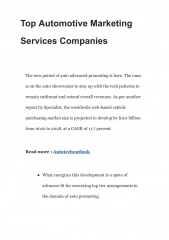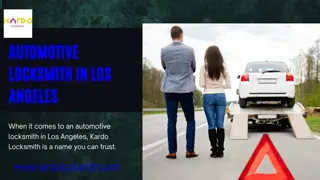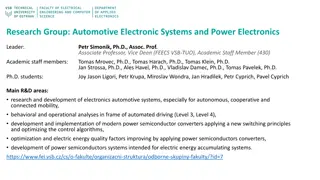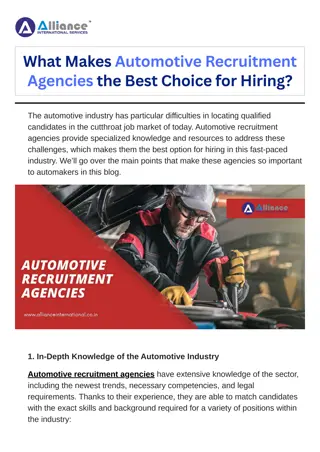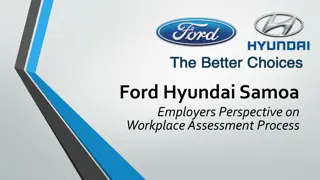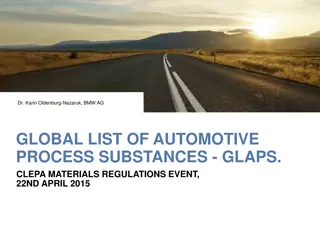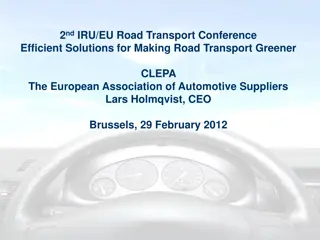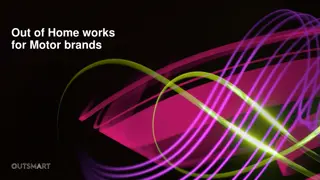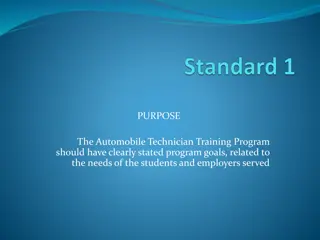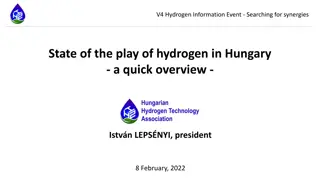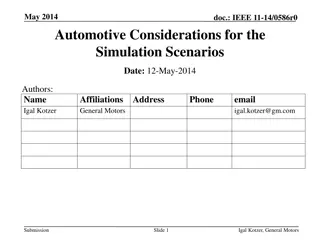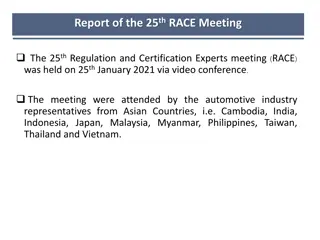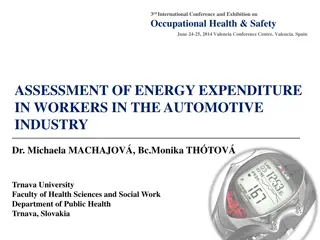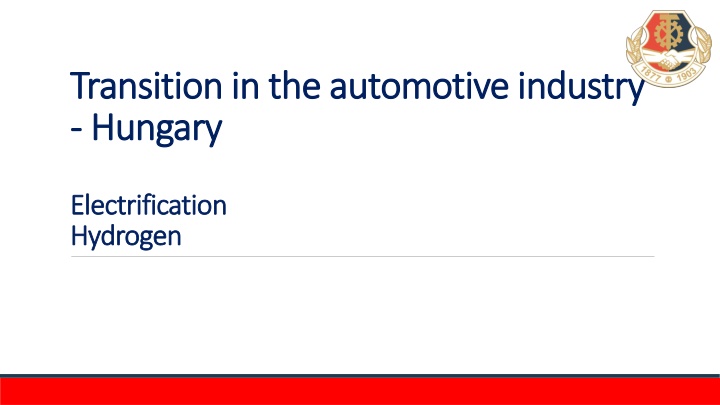
Transition in Hungary: Automotive Industry Strategies 2025
In Hungary, the automotive industry is transitioning towards electrification and hydrogen strategies. Key themes include establishing a local market, supporting OEMs, and addressing labor shortages. Company strategies focus on workforce skills and expansion. Trade unions are adapting to changing priorities. The summary highlights Hungary's situation with OEMs and the need for innovation. The National Battery Industry Strategy aims for sustainability and collaboration with foreign investors.
Uploaded on | 0 Views
Download Presentation

Please find below an Image/Link to download the presentation.
The content on the website is provided AS IS for your information and personal use only. It may not be sold, licensed, or shared on other websites without obtaining consent from the author. If you encounter any issues during the download, it is possible that the publisher has removed the file from their server.
You are allowed to download the files provided on this website for personal or commercial use, subject to the condition that they are used lawfully. All files are the property of their respective owners.
The content on the website is provided AS IS for your information and personal use only. It may not be sold, licensed, or shared on other websites without obtaining consent from the author.
E N D
Presentation Transcript
Transition Transitionin - -Hungary Hungary in the theautomotive automotiveindustry industry Electrification Electrification Hydrogen Hydrogen
State strategy Establishing a local market is not realistic Support of OEMs (MBMH, BMW, Audi) expensive, not transparent, market distorter What left: join the supply chain: National battery strategy Diversification: Hydrogen strategy 2025. m rcius 12., szerda
Company strategies Currently traditional, hybrid and electric are present at the same time labour shortage Automatization where possible, plus foreign workforce (mainly in the supply chain) Moving toward skilled and highly educated workforce (problems with education system) Growing and expansion (new areas) of production 2025. m rcius 12., szerda
Trade unions Strong at OEMs No influence on strategic decisions (even local management often doesn t have a word, only lobbying) New organizing strategies (foreigners, white collars, etc.), as the traditional base is shrinking Slowly changing priorities of members: wages working conditions OHS environment protection 2025. m rcius 12., szerda
Summary Externally controlled Hungary s situation is fairly good (OEMs) Government s priority is the level of employment; innovation, modernization is not Companies aiming to increase added value Suppliers are in a vulnarable situation Trade unions need to adapt 2025. m rcius 12., szerda
Electrification - Batteries National Battery Industry Strategy 2030 Aiming to become the central of European battery value chain and 2nd in the world Socially, economically and environmentally sustainable battery industry Main projects: 1. Recycling facilities 2. Lithium from thermal water 3. Batteries to control the energy market (batteries next to fields of solar panels) 4. Electromobility 5. R+D+I projects Cooperation with EBA Academy Training for vocational schools and colleges Foreign investments (lack of local capital) Investors are mostly from Asia: China and South-Korea For them, Hungary is a gate to EU s single market
Electrification - Batteries More than 20 factories / ongoing investments: SK Innovation/Battery, Semcorp, CATL, Samsung, LG, Jabil Huge state support for new investments Estimatation: by 2025 third in battery production capacity, and 30.000 workplaces On country level currently 2% of the workforce is foreigner In battery production is likely much higher (Ukranians, Serbians, lately from Asia: Mongolia, Philippenes, Vietnam, China, South-Korea)
Electrification working conditions Labor shortage especially in skilled workers Huge problems in the future Labour intensive work Blue and white collars Comparing to an avarege automotive company, the share of white collars is smaller Their role is smaller: no influene on the production process Among blue collars unskilled workers is the biggest group High fluctuation despite the relatively good wages (extra hours are paid well, high bonuses) Because of the working conditions, especially compared to ICE
Electrification working conditions Environmental issues Polluting water, soil, noise OHS issues Ventilation problems Example: Hospitalization of 14 workers Bad, old occupational safety equipments Dangerous materials are not kept well Rewriting the rules Hostility toward unions Cultural differences, local know how is not respected Government doesn t take these concerns seriously or as important
Hydrogen strategy Main aims - 2030 Production of large quantities of low-carbon and decentralized carbon-free hydrogen; Decarbonisation of industrial consumption, partly with hydrogen; Green shipping; Electricity and (natural) gas supporting infrastructure.
Production of hydrogen 2030 Annual 36,000 tons, of which 20,000 blue and 16,000 green hydrogen Currently, only gray hydrogen, i.e. hydrogen with a high carbon footprint, is produced Decentralized instead of centralized production (electrolysis)
Industrial decarbonization Two hydrogen valleys Transdanubian hydrogen ecosystem Production (e.g. Sz zhalombatta), energy for production (Paks) and use (e.g. Dunaferr, Beremend) Northeast Hydrogen Valley (strong chemical industry, petrochemicals)
Greening for transport The goal of the strategy is to help achieve carbon neutrality Hydrogen in heavy vehicle traffic Planned demand: 2030 - 10 thousand tons per year 2040 40 thousand 2050 130 thousand Charging network - 20 stations by 2030
Supporting electricity and natural gas infrastructure Goal: an infrastructure that supports the ability to store seasonal electricity Construction of power-to-gas plants Use of natural gas infrastructure in hydrogen transport
Thank Thank you you! !

